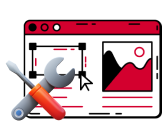Introduction: You Don’t Need to Be Big — Just Brave Enough to Begin
In a small upstairs room in Surat, a 25-year-old weaver launched his handmade clothing brand on Instagram. Just two years later, he was fulfilling international orders. In a narrow street in Kochi, a food blogger started uploading short videos to YouTube. Today, she runs a full-fledged content studio and consults for restaurant chains.
These aren’t unicorns or celebrities. These are everyday small business owners who figured out one thing early: marketing doesn’t reward size, it rewards consistency, clarity, and using the right tools at the right time.
If you're a small business owner in India, chances are you're wearing too many hats — founder, marketer, customer support, finance, maybe even delivery driver. Between the chaos of GST filing and WhatsApp customer queries, marketing can feel like a luxury you can’t afford.
But here’s the truth: you can’t afford not to market. You’ve built something real, and the world needs to know about it. That’s where digital marketing tools come in. Not the ones designed for big-budget global brands. But the smart Indian solopreneurs, startups, and local businesses are using tools that help you show up online, attract your audience, and convert attention into revenue without burning out.
Your Digital Home: Building a Website or Online Store That Works While You Sleep
If your customers can’t find you online, they might never find you at all. For many small businesses across India, from handloom saree sellers in Banaras to fitness coaches in Hyderabad, the biggest turning point isn’t a celebrity shout-out or viral reel. It’s launching its first website not just for credibility, but for visibility, control, and conversions.
In 2025, a digital storefront is no longer optional. It’s your foundation. And the best part? You don’t need to be a techie or spend lakhs hiring a developer. You just need the right tools and some courage to hit publish.
Indian Success Spark: How Sugar Cosmetics Started with a Small Shopify Site
When Vineeta Singh co-founded Sugar Cosmetics, she didn’t launch with 100 stores or a massive marketing agency. She started with a small team, a Shopify site, and a bold focus: India-first beauty for the new generation. From there, the brand scaled into a ₹500+ crore empire. And that first website? It was built using Shopify’s easy-to-use templates.
That’s the power of a good website — it doesn’t just host your products. It tells your story, builds trust, and lets your customers shop, learn, and connect on their terms.
Best Tools to Build Your Website or Store
Shopify India
Perfect for e-commerce stores. Localised payment gateways, shipping options with Delhivery and Shiprocket, and support for regional marketing campaigns. It’s beginner-friendly and built for growth.
Zoho Sites
Homegrown in India, Zoho offers drag-and-drop website building tools with local customer support and deep integration with email, CRM, and finance apps. Great for service-based businesses.
WordPress + Elementor
Ideal for blog-heavy brands, educators, and creators. Free to start with and infinitely customizable. Elementor makes designing pages feel as simple as editing a Canva file.
Instamojo
Loved by Indian solopreneurs and coaches. You get a quick setup for digital product sales, course hosting, and even a payment link generator — no full website needed to get started.
Tip
“When I launched my handmade jewellery brand from Kolkata, I used Shopify’s India plan and paid with UPI. I didn’t think anyone would buy from a small site, but once I linked it on Instagram and added reviews, orders started coming in. It felt surreal.”
Creating Content That Connects: The Tools Behind India’s Boldest Brands
You’ve probably seen it. That Instagram reel of a chaiwala spinning his kettle with flair, getting millions of views. Or the Bengaluru startup founder sharing behind-the-scenes videos of building her brand. Content isn’t just for “influencers” anymore. It’s the heartbeat of discovery, trust, and community for small businesses across India.
But here’s the truth. Creating good content consistently is hard. Especially when you’re doing everything yourself. Writing captions, designing posts, planning your next reel, responding to comments — it adds up fast. The key is to stop doing it all manually and start using smart tools that give you speed, structure, and creative support.
Real India, Real Growth: How The Whole Truth Built a Brand Through Content
Shashank Mehta, the founder of The Whole Truth Foods, didn’t just sell protein bars. He told stories. Personal ones. Struggles with body image. Transparency in food labels. Behind every Instagram post or email newsletter was a layer of human emotion and insight that connected deeply with Indian millennials.
Today, The Whole Truth isn’t just a product, it’s a movement. And behind that movement is an army of smart content planning, writing, and design tools that keep the message clear and powerful.
Smart Content Tools for Small Indian Businesses
Canva
Still, the king is for small business owners who want to design like pros without hiring one. Whether you’re making Instagram posts, packaging mockups, or festival-themed flyers, Canva gives you clean, high-converting visuals with minimal effort. Their India team also curates seasonal templates for local festivals like Diwali and Holi.
InVideo
Made in India and perfect for video-first marketing. With drag-and-drop editing, stock footage, and templates designed for Indian audiences, you can turn product shots or testimonials into Instagram reels or YouTube ads that look professionally edited.
Lately AI
It takes your long-form content, like a blog or podcast, and turns it into dozens of social media posts. A huge time-saver for creators and coaches who want to be everywhere without burning out.
Notion
More than a note-taking app. It’s a full content calendar, team planner, and editorial assistant. Many Indian startups are building their entire marketing workflow inside Notion because it keeps everything from campaign ideas to caption drafts in one place.
Content That Builds Trust: Not Just Likes
The mistake most businesses make? Posting just for the sake of it. What wins is posting content that solves a problem, tells a story, or helps someone feel seen. That is what people remember and share.
You don’t need perfect grammar or high-end cameras. You need consistency, clarity, and a deep understanding of your audience. Use tools to handle the load. Focus your energy on being real, not being viral.
Experience
“I used to post only when I felt inspired. But using Notion for my content calendar and InVideo for quick reels changed everything. Now I have a full month planned, and I still have time to run my bakery.”
Building Relationships, Not Just Lists: Email Marketing Tools That Work
Email isn’t dead. In fact, in a country where WhatsApp rules and social media reach can vanish overnight, email is one of the few channels you truly own. It’s quiet. Personal. Powerful. And when used well, it can become the most valuable marketing asset for a small business in India.
But here’s the problem. Most small business owners think email is just for big e-commerce brands or IT companies. They underestimate it. Meanwhile, smart founders and solopreneurs are using simple emails to build community, nurture trust, and increase sales, all without spamming or sounding robotic.
A Story from the Streets of Pune
Meera runs a handmade jewelry business from her one-bedroom apartment in Pune. Her first few sales came through Instagram. But growth was slow. She didn’t want to shout louder. She wanted to connect deeper.
So she started sending weekly emails to her small list. Nothing fancy. A story about the design behind a necklace. A thank-you note after a festival season. A peek into her sketchbook. Within months, her email list outperformed Instagram in sales. Her customers didn’t just buy. They replied. They shared. They felt like they knew her.
That’s the power of email when you treat it like a conversation, not a broadcast.
Tools That Help You Send Emails People Actually Want to Read
MailerLite
One of the easiest tools for beginners who want to build email campaigns without stress. It’s clean, intuitive, and the free plan is generous. You can create landing pages, welcome emails, and even simple automations that make you look like a pro.
ConvertKit
Loved by creators across India, from course sellers to yoga coaches. It helps you segment your audience based on what they’re interested in, so they never feel like they’re getting the same generic newsletter. You can create beautiful forms, set up email sequences, and even sell digital products directly.
Zoho Campaigns
Homegrown and powerful. Zoho integrates beautifully with other business tools like Zoho CRM or Books. For Indian SMBs looking for an all-in-one ecosystem, it’s a solid pick.
Brevo (formerly Sendinblue)
For those who want a more advanced tool with SMS marketing options and CRM features built in. Brevo has been gaining traction in India, especially for B2B businesses and service providers.
What to Send if You're Just Starting Out
Don’t overthink it. Your first email doesn’t need to be a polished newsletter. Think of it as writing to a friend.
Share a behind-the-scenes story.
Tell them why you started your business.
Offer a free tip or tutorial.
Send a thank-you or festival greeting.g
Answer a common question your customers have
It’s not about selling in every email. It’s about showing up consistently and making people feel like they matter. Do that, and when you finally do make an offer, it won’t feel like a pitch. It’ll feel like a recommendation from someone they trust.
Quick Tip
Start your email list even if you have only five people. One of them could be your first brand evangelist. And once you experience the magic of getting a reply that says, “This helped me,” you’ll never see email the same way again.
From Reels to Revenue: Social Media Tools That Save Time and Sanity
Social media used to be simple. Post a photo, add a filter, maybe write a witty caption. Now? It’s a whirlwind of trends, audio clips, hashtags, algorithm changes, and platform juggling. For small business owners in India, especially those outside the metro cities, this can feel like a full-time job. And most of them are already wearing five other hats.
Yet, social media is non-negotiable. It’s where your customers are scrolling late at night. It’s where they discover new brands. It’s where trust is built before a single rupee is spent. So,o how do you stay visible without burning out?
You need tools that help you show up consistently without draining your creative energy. Tools that turn chaos into calm, and let you focus on your message instead of struggling with the mechanics.
How an Indore-Based Saree Seller Went Viral Without a Marketing Team
Aarohi had never taken a marketing course. She didn’t even know what an “engagement rate” was. But she knew her audience, middle-class Indian women who wanted modern sarees with traditional roots.
She started by recording short videos explaining her fabric choices. Her daughter helped her shoot them in their living room. She used a scheduler to post regularly and repurposed each video into Instagram Reels, Facebook posts, and YouTube Shorts.
Her consistency paid off. Within six months, she doubled her monthly orders. Not because she had a content studio, but because she had the right tools to amplify her voice.
Social Media Tools That Are Changing the Game in India
Buffer
Simple and perfect for scheduling posts across platforms like Instagram, Facebook, LinkedIn, and Pinterest. It gives you a clean dashboard where you can plan your week in one sitting. Great for solo entrepreneurs who want clarity.
Flick
Originally built for Instagram hashtag research, Flick now includes content idea generation and post rewriting. Indian digital coaches and creators use it to generate variations of one post for multiple platforms. It’s smart, time-saving, and great for idea-block days.
SocialPilot
Built with Indian agencies and SMBs in mind, SocialPilot lets you manage multiple accounts and schedule content in bulk. It also provides detailed analytics, helping you see what’s actually working.
Metricool
Becoming popular among Indian D2C brands. It combines scheduling with performance tracking, competitor analysis, and real-time audience interaction all in one place. Many Shopify brands in India are now adopting it as their go-to dashboard.
Kuku FM + Trell Trends
For regional content creators, these platforms provide insight into what’s trending across tier-2 and tier-3 cities. You can use these tools to align your content with regional interests, from Bhojpuri music to Tamil lifestyle trends.
Social Media Without Stress: A Mindset Shift
Too many businesses chase trends without a plan. They post three days in a row, disappear for two weeks, and wonder why nothing works. The truth is, consistency matters more than virality. A thoughtful post that gets 50 saves is more valuable than a reel that gets 5000 empty views.
Use tools to create a sustainable system. Start with just one platform. Batch your content weekly. Schedule in advance. Then focus on engaging with real people, replying to comments, asking questions, and sharing stories.
Don’t try to go viral. Try to be valuable. That’s what creates the kind of social media presence that people come back to.
One Last Thought
If you feel overwhelmed, you’re not alone. Even full-time marketers feel that way. But once you let tools handle the repetition, you’ll find the freedom to create with heart again. And your audience will feel that difference, they always do.
Data Without the Drama: Tools That Show You What’s Really Working
Most small business owners in India don’t have time to dive into dashboards or learn the language of bounce rates and click-throughs. They’re trying to grow from the ground up, often alone, juggling inventory, customer service, payments, and social media.
And yet, decisions need to be made daily. What time should you post that reel? Which product page is losing visitors? Why did your last email campaign flop while the one before it soared?
Without data, those answers are guesses. But with the right tools, they become insights you can act on.
From Gut Feeling to Informed Growth: The Power of Knowing Your Numbers
Ramesh owns a small leather goods brand in Kanpur. For months, he thought Instagram was his best-performing channel. He poured money into influencers, reels, and ads.
But after setting up proper analytics with Google Analytics 4 and integrating it with Shopify, he noticed something surprising. Forty percent of his conversions were coming from Pinterest, mostly from women saving his bags to style boards. His Instagram traffic was high, but not converting.
He shifted his strategy, optimized his product pages for Pinterest traffic, and launched a creator campaign on that platform. Within 90 days, his sales rose by 38 percent.
All it took was better visibility into what was already happening.
Analytics Tools Every Indian Business Should Consider
Google Analytics 4 (GA4)
Yes, it looks intimidating at first. But GA4 is one of the most powerful free tools available. You can track user behavior, see where your visitors drop off, and understand how they move through your website or app. And in 2025, GA4’s simplified dashboards have made it more beginner-friendly than ever.
Zoho PageSense
Built by an Indian company and ideal for SMBs, PageSense offers heatmaps, session recordings, A/B testing, and funnel tracking. It’s perfect if you want to know exactly how people interact with your website, where they click, where they scroll, and where they leave.
Microsoft Clarity
A free and underrated gem. It shows you session recordings and heatmaps without eating into your site’s speed. Several Indian startups use it to fix UX issues and improve conversions without hiring a full design team.
Hotjar
Used by growing brands in India like Bombay Shaving Company and Lenskart. It gives deep insights into user behavior with surveys and visual click tracking. Great for when you’re redesigning a product page or testing new CTAs.
Facebook Business Suite Insights and Instagram Creator Studio
These aren’t just for ad performance. You can also track audience growth, post reach, and engagement patterns. For solopreneurs and creators, these platforms offer bite-sized metrics that help you fine-tune your content strategy weekly.
A Data-Driven Mindset Without the Overwhelm
You don’t need to track everything. Start with the basics. Where are your customers coming from? Which product or post leads to actual sales? Are your visitors leaving before checking out?
Pick two or three KPIs that matter for your current stage. Maybe it’s sales, maybe it’s form signups, maybe it’s time on site. Focus there. Use tools to track changes. Then improve what matters.
Don’t chase vanity metrics. Ten thousand followers mean nothing if they don’t engage. A hundred loyal buyers who read your emails, share your posts, and return again and again, that’s what builds a real business.
Why Small Indian Brands Have an Advantage Here
You’re closer to your customers than large corporations. You hear their feedback directly, you can adapt faster, and you don’t need a complex analytics team to spot trends. You just need tools that simplify the noise and highlight the truth.
Once you start seeing your data clearly, it’s addictive. You stop guessing. You start testing. And the feeling of confidence that comes with that clarity? That’s priceless.
The Inbox Isn’t Dead: Email Marketing Tools That Connect
You know the feeling. You pour your heart into an Instagram post, maybe even boost it for a few hundred rupees. It gets likes, a few comments, but not much else. Then you send a short, honest email to your mailing list, and suddenly five orders roll in.
That’s the quiet power of email. It isn’t flashy. It doesn’t go viral. But it builds relationships in a way few channels can match.
For small businesses in India, email is often overlooked in favor of newer platforms. But in 2025, it’s making a strong comeback. Why? Because people are tired of constant noise. They want real conversations. And their inbox is still one of the most personal digital spaces they own.
Real-World Story: How One Gujarati Artisan Built Loyalty Through Email
Meet Priyanka, a handmade jewelry creator from Ahmedabad. In the beginning, she focused solely on Instagram. But competition was fierce. Algorithms changed. Her reach dropped.
Instead of giving up, she started collecting emails at flea markets and on her website with a simple message "Join my private circle and get early access to new designs."
She used MailerLite to send simple emails. One story per week. Sometimes about her design process. Sometimes about her life. No tricks. No big discounts.
Six months later, email made up 65 percent of her monthly income. Customers replied with messages like, “I wait for your emails every Sunday,” or “Your story about your grandmother reminded me of mine. I had to buy that piece.”
That’s the kind of bond Instagram can’t always create.
The Best Email Marketing Tools for Indian Small Businesses in 2025
MailerLite
Perfect for beginners. Clean interface, free for up to 1,000 subscribers, and automation that feels easy. Great for solopreneurs who want to build trust, not just blast offers.
ConvertKit
Ideal for creators, coaches, and independent professionals. What makes it special is how it handles audience tagging and sequences. If you want to send the right message to the right people at the right time, ConvertKit is your friend.
Zoho Campaigns
Made in India and built for Indian entrepreneurs. Integrates with Zoho CRM, which many small service businesses use. Offers detailed reporting, templates, and A/B testing at a fraction of the cost of global platforms.
Brevo (formerly Sendinblue)
Affordable and powerful. Used by many mid-sized Indian businesses, Brevo offers email, SMS, and WhatsApp automation in one platform. Its analytics features are robust, which makes it a good step-up once your business grows.
Mailchimp
Still a favorite for startups and small agencies, Mailchimp is visual and friendly. Though more expensive than others for higher lists, its drag-and-drop editor and integrations with Shopify or WooCommerce make it a solid choice.
Building a Relationship, Not Just a List
Most small businesses make the mistake of focusing on how big their list is. That’s not what matters. What matters is how engaged your subscribers are. Do they open your emails? Do they reply? Do they feel like they know you?
The best way to grow engagement is to stop selling in every email. Share your journey. Talk about challenges. Ask questions. Make people feel like insiders.
If you’re an Ayurvedic brand, send tips on daily rituals. If you’re a clothing brand, share behind-the-scenes from your workshop. If you’re a home baker, share your first baking fail.
Emails are stories disguised as marketing. Use them wisely, and your customers will feel like part of something special.
Small Effort, Big Return
You don’t need to send daily emails. One good email a week can outperform 20 Instagram posts if done right. Set aside one hour every Thursday. Write to your audience like they’re your friend. Give value. Then ask for the sale gently.
And when the orders start coming in, you’ll know you’ve built something sustainable, not just social buzz, but a customer base that trusts you.
Word of Mouth Has Gone Digital: Influencer and Affiliate Tools That Work
Think back to how most Indian families discover new products. A friend mentions a great home baker. A cousin swears by a new herbal oil. A neighbor recommends a tuition teacher. That chain of trust is how our economy has always worked.
Now, in 2025, that same chain lives online.
It lives on Instagram reels. In YouTube vlogs. In WhatsApp groups. And increasingly, in affiliate recommendations. Small businesses don’t need celebrity endorsements anymore. They need micro-influencers who speak their language and share their values.
This is where influencer and affiliate marketing come into play. Not as a flashy tactic, but as a return to that ancient Indian principle: people trust people.
Story from the South: How a Tamil Nadu Tea Brand Sold Out in 48 Hours
An organic tea company in Coimbatore had a limited marketing budget. Instead of running Google Ads, the founder partnered with ten local Instagram creators with 5,000 to 20,000 followers. These weren’t models or lifestyle gurus. They were yoga teachers, homemakers, and wellness bloggers.
Each of them received a small product kit and shared honest feedback through stories and reels. One creator even shared how she brewed the tea during her morning prayer ritual. The connection was real. The response was overwhelming. Every unit was sold out in 48 hours.
No actors. No marketing agencies. Just trust and storytelling.
The Best Influencer & Affiliate Tools for Indian Small Businesses in 2025
Shopify Collabs
If you run your store on Shopify, this tool makes it incredibly easy to invite influencers or creators to promote your products. They get custom affiliate links, and you can track clicks, conversions, and payouts. Even better, they have access to a discovery tool to find new creators.
Kofluence
An Indian-grown platform that helps brands connect with influencers based on niche, language, audience, and budget. Kofluence understands the Indian market. You can run campaigns in regional languages or target a specific city.
Qoruz
Used by many D2C startups and agencies, Qoruz helps you find the right influencers across Instagram, YouTube, and even Twitter. It offers data on engagement, follower quality, and content type so you're not guessing.
Impact
This one’s great for brands wanting a more structured affiliate program. You can onboard influencers, bloggers, and content creators, give them performance-based commissions, and track everything inside one dashboard.
Roposo Clout
Emerging from the Indian short-video space, Roposo Clout allows small businesses to collaborate with creators on platforms like Glance, Moj, and others that are wildly popular in Tier 2 and Tier 3 cities.
Tips for Doing Influencer Marketing the Right Way
Start small. Don’t go chasing influencers with a million followers. Focus on people who genuinely like your product and speak to your audience. If you're a handmade saree brand, reach out to cultural content creators or dance teachers. If you're a local spice brand, find food bloggers who cook Indian dishes on YouTube.
Always ask influencers to use the product. The most powerful posts are the ones that show usage, emotion, and real experience. Audiences can spot a paid post in seconds. But if someone says, "This helped me sleep better," or "My child loves this chocolate spread," people believe it.
Don’t forget to follow up with the data. Track which influencers bring the most clicks or sales. Use UTM parameters or affiliate links. Learn, improve, and invest more in those who deliver results.
Affiliate Marketing: Your Customers Become Your Ambassadors
Beyond influencers, think about your customers. Some of them love your brand. Why not reward them for recommending you?
Set up a small affiliate program using tools like Refersion, FirstPromoter, or even a Google Form and manual tracking. Give 5 percent or 10 percent commission for each sale they generate. You'll be amazed how excited loyal customers get when there's something in it for them, too.
This approach works beautifully in Indian communities where trust is everything. A woman who recommends your mehendi cones to her WhatsApp group becomes your best marketing channel. A tuition parent who shares your math course with her school group might bring you 20 new leads.
You Don’t Need Virality. You Need Connection.
Influencer marketing isn't about going viral. It's about finding 50 people who trust you, and helping them tell your story. With the right tools and a lot of heart, you can do this with zero ad spend and zero marketing degree.
When you see a YouTube video where a creator lovingly opens your packaging. When an Instagram post shows your product being used in a real home. That’s when you know you're building something real. Not hype. Not noise. A business that lasts.
Turning First-Time Buyers into Loyal Fans: Customer Support and CRM Tools That Scale With You
Walk into any Kirana store in India and you'll see something magical. The owner remembers your name, knows what brand of biscuits your kid loves, and probably even offers to drop your groceries at home if it starts to rain. That personal touch builds loyalty that no ad ever could.
But how do you recreate that magic online?
This is the challenge facing small businesses today. You're selling through Instagram, Shopify, WhatsApp, and Amazon. Your customer isn't across the street anymore. They're in another city or even another state. They expect fast replies, smooth transactions, and thoughtful service. That’s where customer support and CRM (Customer Relationship Management) tools come in.
And the best part? You don’t need a call center or a big budget. You just need the right tech.
The Indian Ayurveda Brand That Built a WhatsApp Army
A bootstrapped Ayurvedic skincare brand from Jaipur faced a common issue. Their Instagram ads were working, but once people ordered, questions started pouring in. “Will this help pigmentation?” “Is this safe during pregnancy?” “How long before I see results?”
They turned to Zoko, a WhatsApp commerce tool that helped them create automated responses, quick reply templates, and even a product catalog within chat. Suddenly, their DMs weren’t chaotic. Customers were getting real answers, fast.
The result? Not only did repeat orders increase by 63 percent over 4 months, but customers began sharing screenshots of their chats online, praising the personal attention.
The Best CRM and Support Tools for Indian Small Businesses in 2025
Zoho CRM
Built in India, Zoho is globally respected and extremely affordable. It helps you track leads, automate follow-ups, and stay organized. Whether you're a coaching business or an e-commerce store, Zoho helps you see every customer’s journey in one place.
Freshdesk by Freshworks
Another Indian-born gem, Freshdesk lets you handle customer questions across email, chat, Facebook, and WhatsApp from a single dashboard. Its automation features help you reduce response time without losing the human touch.
Zoko
Perfect for WhatsApp-first brands, Zoko offers campaign blasts, support chats, and even abandoned cart recovery all through one of India’s most trusted messaging platforms.
Tidio
If your website is your main storefront, Tidio helps you greet visitors with an AI-powered chat assistant. You can guide shoppers, answer questions, and even collect leads while you sleep.
HubSpot CRM
For those scaling a little faster, HubSpot’s free CRM gives you powerful tools for lead capture, email automation, and contact segmentation. It’s clean, intuitive, and great for service-based businesses.
Why CRM Isn’t Just Software, It’s a Relationship Philosophy
Let’s be real. People don’t return to your brand because your email template looked fancy. They return because you remembered their birthday, because you solved their issue without passing the blame, and because they felt seen.
CRM tools don’t replace kindness. They just make it easier to deliver it at scale.
In Indian culture, relationships matter. We call our vendors “bhaiya” and our customers “didi.” The digital world doesn’t have to kill that warmth. With the right tools, it can enhance it.
Final Thoughts: The Future Is Small, Bold, and Digital
If you’ve made it this far, you’re not just a business owner. You’re a dreamer. You’re someone who’s fighting to build something meaningful in a noisy, competitive world. That’s not easy.
You might not have an MBA. You might not have investors backing you. But you have passion. You know your community. You understand your product. And with the right tools, you can build systems that let you do more with less.
In 2025, small businesses in India aren’t small in spirit. They’re agile. They're brave. They're growing from living rooms, garages, and small-town offices powered by creators, solopreneurs, homemakers, and hustlers.
The tools we’ve explored in this guide aren’t silver bullets. But they are levers. When used wisely, they can lift you higher. They can give you back time. They can help you turn ideas into income and followers into family.
So, whether you're selling homemade candles, building an app, running a coaching business, or starting a café, remember this:
You're not too late. You're right on time.
And India, with all its complexity and color, is ready to support your journey. One click, one conversation, one customer at a time.
Let’s build that future together.
 Bundles
Bundles Flash Sales
Flash Sales






















Comments (0)